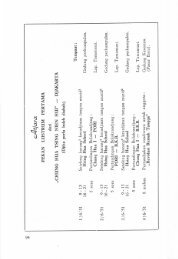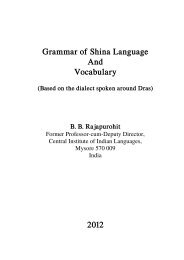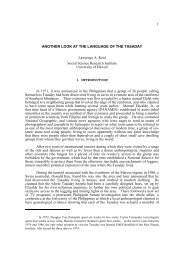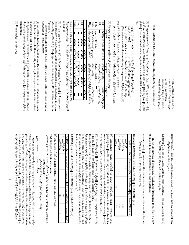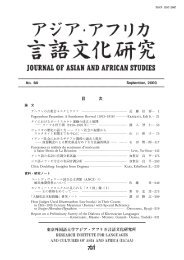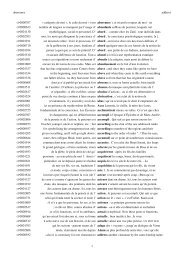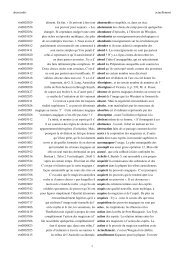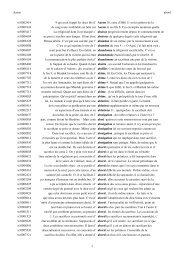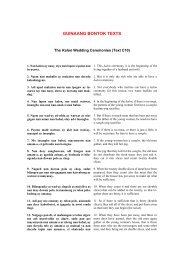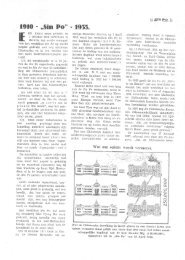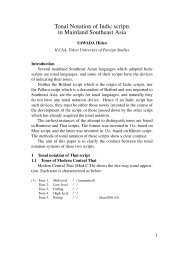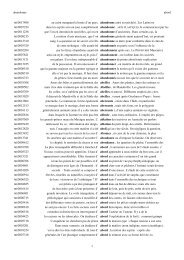PËa-prefixation on verbs and auxiliaries in Lhaovo (Maru) Language ...
PËa-prefixation on verbs and auxiliaries in Lhaovo (Maru) Language ...
PËa-prefixation on verbs and auxiliaries in Lhaovo (Maru) Language ...
Create successful ePaper yourself
Turn your PDF publications into a flip-book with our unique Google optimized e-Paper software.
(17) a. PăfoPH luFluF-tsaL NatF-TA A leaf is wide <strong>and</strong> th<strong>in</strong><br />
leaf wide&th<strong>in</strong>RDPL-<strong>on</strong>ly CPL-RLS<br />
b. PăfoPH luFluF-tsaL-TA ruF<br />
leaf wide&th<strong>in</strong>RDPL-<strong>on</strong>ly-ATTR th<strong>in</strong>g<br />
a wide <strong>and</strong> th<strong>in</strong> leaf (lit. a leaf, <strong>and</strong> what is wide <strong>and</strong> th<strong>in</strong>)<br />
(18) Pă- as a nom<strong>in</strong>alizer prefix<br />
PăGiL<br />
big <strong>on</strong>e<br />
< GiL ,<br />
to be big<br />
PălauNF<br />
heat<br />
< lauNF ,<br />
to be hot<br />
PămyōNF<br />
height<br />
< myōNF<br />
to be high<br />
Păp<strong>in</strong>F<br />
end<br />
< p<strong>in</strong>F<br />
to end<br />
PăpuNH<br />
hole<br />
< puNH ,<br />
to hole<br />
PăNø¯<br />
H<br />
lid<br />
< Nø¯<br />
H ,<br />
to cover<br />
PătaNL<br />
bunch<br />
< taNL ,<br />
to bunch<br />
PăsoL<br />
mark<br />
< soL<br />
to mark<br />
Pă-AUX sentences have quasi-attributive structure: a nom<strong>in</strong>alized AUX with an attributive clause<br />
2.3.2 Pă-TA after AUX (clearly detected <strong>on</strong>ly <strong>in</strong> case AUX is -šiL‘still’/-loL‘anymore’. See (6))<br />
Take it a special case of the marker of positive Realis Informative sentence.<br />
(19) a. Păy-meNF naF -TA-TA Pă-šiL-TA . ‘It is that (he) is/was still there.’<br />
there-LOC stay-RLS-ATTR PRF-still-RLS (reanalysis of (2c))<br />
b. Păy-meNF mă-naF -φ-TA Pă-šiL-TA . ‘It is that he is/was not still there’<br />
not-stay-NEG-ATTR<br />
cf. Păy-meNF<br />
there-LOC<br />
naF-šiL-TA-TA<br />
stay-still-RLS-ATTR<br />
ruF<br />
th<strong>in</strong>g<br />
NatF-TA(-raH) .<br />
CPL-RLS(-RA)<br />
(‘Truly attributive’ versi<strong>on</strong> of (19))<br />
2.3.3 Factors limit<strong>in</strong>g sentences hav<strong>in</strong>g Pă-AUX counterpart to Realis Informative <strong>on</strong>es<br />
• Morphological factor: an overt sentence marker is <strong>in</strong>compatible with nom<strong>in</strong>alizati<strong>on</strong> by Pă-,<br />
(20) *naF-TA-TA<br />
stay-RLS-ATTR<br />
Pă-neNH<br />
PRF-IRL<br />
/ *naF-TA-TA Pă-laNL<br />
PRF-HORT<br />
/ *naF-TA-TA Pă-šoNL<br />
PRF-OPT<br />
nor an AUX-sentence marker complex.<br />
• Semantic factor: quasi-attributive structure does not fit the purpose of express<strong>in</strong>g such speech act as order,<br />
request, hortati<strong>on</strong>, prayer etc. * 10<br />
*9 -raH is a particle which occurs after Realis attributive clauses <strong>and</strong> positive Realis sentences. In an attributive clause, it functi<strong>on</strong>s as an<br />
overt l<strong>in</strong>ker between the clause <strong>and</strong> its head noun, support<strong>in</strong>g n<strong>on</strong>-segmental marker -TA. In a positive Realis sentence, -raH <strong>in</strong>dicates<br />
the high degree of formality. Its orig<strong>in</strong>al functi<strong>on</strong> would be the former.<br />
*10 However, the factors menti<strong>on</strong>ed above cannot expla<strong>in</strong> the ungrammaticality of the follow<strong>in</strong>g sentence:<br />
*naF-neNH-TA<br />
stay-IRL-ATTR<br />
Pă-šiL-TA<br />
PRF-still-RLS<br />
5



